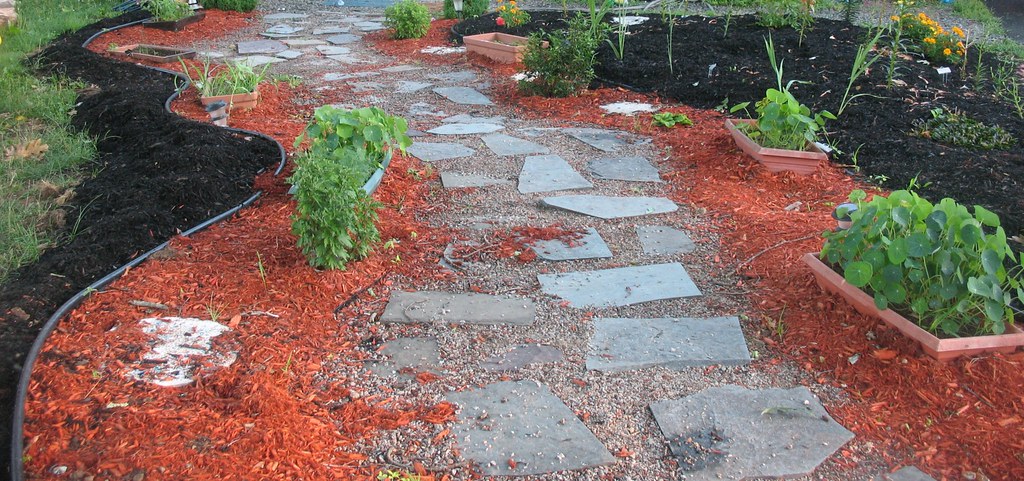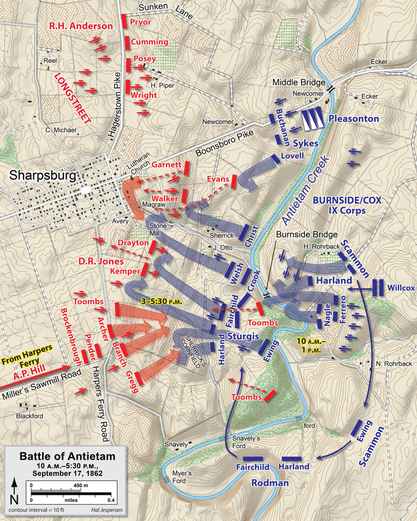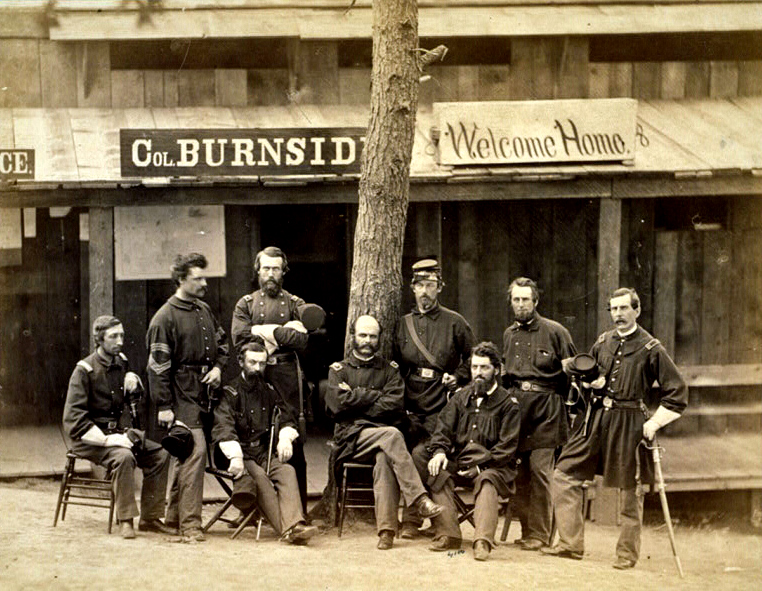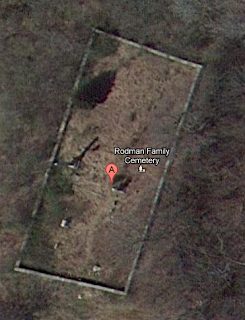Essays about history, stories, art, technology, living memory, science, material culture, architecture, gardens, molecular structures! Also, news about Rhode Island and New England history, reviews of books, lectures and more!
Tuesday, August 21, 2012
Remembering (and Forgetting) General Isaac P. Rodman
Isaac Rodman, a native son of South Kingstown, Rhode Island, was the highest ranking officer from Rhode Island to fall in the Civil War. Antietam National Battlefield had "Rhode Island Day" on August 11, 2012, and held a memorial to General Rodman. The Pettaquamscutt Historical Society, which is planning to open an exhibit in remembrance of General Rodman on September 17, currently has a display at the visitor's center at Antietam that features "General Rodman's sword and the photograph from which the posthumous formal portrait was painted (which is on a wayside on the Battlefield), and Patrick Lyons photograph and his diary opened to the entry about discovering Rodman had been mortally wounded" (quote and photo of the Rodman display at Antietam National Battlefield courtesy of Lori Urso, director of the Pettaquamscutt Historical Society; Lori has also posted on the PHS website an account of her visit to Antietam last summer retracing General Rodman's footsteps at his last charge at Antietam). Thousands of visitors this summer will see these relics of Rhode Island history and reflect on the sacrifice made by Isaac Rodman and the 52 other Rhode Islander's who also died at Antietam in "the bloodiest single-day battle in American history, with about 23,000 casualties on both sides."
Isaac Rodman was born in South Kingstown, RI, in 1822, and save for the last 15 months of his life when he served in the Union army, he lived his entire life there. Rodman came from solid New England stock. His first American ancestor, Dr. Thomas Rodman, was a Quaker from Barbados who arrived in Newport in 1675 as King Phillip's War was about break out. His son, Thomas Rodman Jr, was also a doctor. He moved to Kingstown to take up residence on 1000 acres of land the town of Newport had gifted his father for his services as a doctor. Thomas Jr. died in 1775, exactly one century after his father had arrived in Newport, and the year that the American Revolution broke out.
In 1799, Isaac Rodman's grandfather Robert married into the Hazard family, South Kingstown's pioneering industrialists. Isaac Rodman had himself been named after Isaac Peace Hazard, who had taken over the Peace Dale mills in 1819 with his brother, Rowland Gibson Hazard II (after whom Rodman's younger brother was named for). In 1835 Isaac's father Samuel Rodman bought the small mills at Rocky Brook in South Kingstown just to the north of Peace Dale, and there rebuilt a single, more substantial mill seat. Samuel Rodman's mills manufactured woolens and jean cloth for southern markets, and Isaac entered into the family business by managing the Rocky Brook Store, selling dry goods and textiles to the mill hands and local neighborhood (ads are from the Narragansett Times, January 14, 1860). By this time Samuel Rodman had followed his wife Mary (née Peckham) into the Wakefield Baptist Church, and Samuel had become a staunch supporter of the local temperance movement. Despite a long family association with the Society of Friends, Isaac and his brothers and sisters were all raised as Baptists. In the 1840s, like their namesakes the Hazard brothers, Isaac and his brother Rowland became textile manufacturers, entering into a partnership with their father that was called S. Rodman & Sons.
Along with managing the mill, in 1847 Isaac married Sally Lyman, the daughter of former RI governor Lemuel Arnold and entered into town politics shortly after. Isaac and Sally had seven children between 1848 and 1860, and Rodman served on the school committee from 1849 to 1854, and again in 1859. In 1856 Isaac was appointed to the board of trustees of the Wakefield Institute for Savings Bank, and was also appointed director of the Wakefield Bank. That same year S. Rodman & Sons bought the Wakefield Mills from Stephen Wright, a South Kingstown blacksmith who moved west in the 1830s and after the discovery at Sutter's Mill in 1848, struck gold himself by setting up the very first bank in San Francisco. Wright had decided to move back to California, and the Rodman's took over his industrial holdings. Isaac Rodman ran for town council on the National American Party ticket and won in 1858, winning the second highest number of votes that year. He led the effort to organize the Narragansett Library Association and build a library in Peace Dale on land donated by the Hazard’s. Rodman organized the Wakefield Trust Company around this time. In 1859 Rodman canvassed the town’s voting list, apportioned the town’s highway tax, made out the list of jurors, and at the June town election was voted both auditor of the town treasury and first tax assessor (see June 1859 town election results, above). On April 4, 1860 Rodman was elected state senator for South Kingstown, and town moderator at the November 1860 town meeting.
Had the Civil War not interrupted, quite likely Isaac Rodman, a well-regarded South Kingstown businessman and politician, would have continued his cursus honorum, perhaps entering (like his colleague on the town council, Elisha R. Potter, Jr.) into state and national politics. That he might have lived to see his great-grandchildren and the first decades of the twentieth century is good possibility too; he certainly came from long-lived genes. In an age before modern medical procedures and antibiotics, his male ancestors going back to Dr. Thomas Rodman all lived at least to age sixty; some had even made it into their late eighties and early nineties, and his father lived to age 82. However, as the United States slid inexorably toward Civil War in the late winter and early spring of 1861, Isaac Rodman arrived at the sudden, fateful decision that the only option left to defend the Union was to take up arms. He burst into the office of Rhode Island's secretary of state and demanded that the Narragansett Guards, South Kingstown's long-defunct local militia, be resurrected. At the company's first drill on April 19, 1861 Rodman was voted its captain. In late May, S. Rodman and Sons went into receivership; orders of negro cloth had come to a halt in the wake of southern secession, and the Rodman's lost their Rocky Brook mills as well as their factories in Wakefield. At the June 4, 1861 town meeting, Isaac Rodman’s last official act for South Kingstown was to submit his audit of the town treasurer’s account to the town meeting; later that morning he said goodbye to his wife Sally and led what had now become Company E of the 2nd Rhode Island Regiment to the Kingston Station. A little more than a month later, at the First Battle of Bull Run, Rodman led the Rhode Island company in a desperate bayonet charge not unlike the one at Antietam that would take his life fourteen months later .
Above: The Battle of Antietam. Rodman's final maneuvers in the battle are on the lower left. Attribution: Map by Hal Jespersen, www.posix.com/CW
Below: The officers of the 1st Rhode Island. Isaac Rodman is leaning against the tree; Ambrose Burnside is sitting to Rodman's lower right.
The Battle of Antietam was a turning point in the Civil War. Though General McClellan's inexplicable caution during and immediately afterward have led military historians to deem the battle a tactical draw at best, the fact that Lee left the battlefield first meant that the North had won a strategic victory, as Abraham Lincoln had been waiting for just such a victory to unveil a piece of critical policy. On September 22, even as Isaac Rodman lay dying in a field hospital from a Minié ball that had torn through his left lung, the President acted on the basis of a Northern victory at Antietam to issue the Emancipation Proclamation. This transformed the Civil War from a limited war to restore the Union to a total war on the institution of slavery and upon the southern plantations that were the economic engine of the southern war effort. The Proclamation also made it all the less likely that the public in France or Britain would support their government's involvement in a war to preserve Southern slavery, and neither would enter the conflict on behalf of the Confederacy. Less than a year later on July 4, 1863, dual Union victories at Gettysburg and Vicksburg all but sealed the Confederate's fate.
Isaac Rodman returned home to a hero's welcome. Flags across Rhode Island were lowered to half-staff, and his funeral was held in Providence's State House, the first time that the capital had been used for a public funeral. Newspapers across the state devoted their front pages to detailing the somber ceremony. Senator Henry Anthony delivered these words for Isaac Rodman's funeral oration:
“Here lies the true type of the patriot soldier. Born and educated to peaceful pursuits, with no thirst for military distinction, with little taste or predilection for military life, he answered the earliest call of his country, and drew his sword in her defense. Entering the service in a subordinate capacity, he rose by merit alone to the high rank in which he fell; and when the fatal shot struck him, the Captain of one year ago was in command of a division. His rapid promotion was influenced by no solicitations of his own. He never joined the crowds that throng the avenues of preferment. Patient, laborious, courageous, wholly devoted to his duties, he filled each place so well that his advancement to the next was a matter of course, and the promotion which he did not seek sought him. He was one of the best types of the American citizen; of thorough business training, of high integrity, with an abiding sense of the justice due to all, and influenced by deep religious convictions. In his native village he was by common consent the arbitrator of differences, the counselor and friend of all.”
- from Robert Gough, "South Kingstown’s Own," page 84
In the town clerk's office at the South Kingstown Town Hall, a large brass plaque commemorates Isaac Rodman and the men of South Kingstown's Company E, many of whom had worked for Isaac Rodman in one of his textile mills before the war. I had idly glanced at the plaque many times when signing in and out of the town records' vault during my MA research, noting the familiarity of many of the names (including Isaac Rodman's) in the town records, but usually giving little thought to the larger historical importance of Isaac Rodman or his men to the Civil War effort. Thinking back on my education, not once did Isaac Rodman's name come up in a high school discussion, not even in college history courses I had taken at URI. Indeed, even the academic building named "Rodman Hall" on the Kingston campus is named after some other Rodman, as it turns out. Isaac Rodman's sacrifice, like many other important pieces of South Kingstown's past, has been all but forgotten by both his town and his state.
Rodman's body was brought back to South Kingstown, and he was buried less than a mile from the Town Hall in the Rodman Family Cemetery (South Kingstown Historic Cemetery #30). Local veterans and then the G.A.R. (Grand Army of the Republic) Post in Wakefield held graveside memorials every year until, in the early twentieth century the G.A.R. post closed and the veterans of the Civil War died off. In the intervening years, the Rodman lands have been sold and resold, and the hill-top cemetery where General Rodman is buried is now in the midst of a large gravel operation (below). The current Google Maps image of the site (left) was likely taken in the winter or early spring of 2012; the General's obelisk casts a long thin shadow on what appears to be open ground. A visit to the Rodman Cemetery last month however, revealed the extent of the neglect of the final resting place of Rhode Island's only Civil War general killed in the line-of-duty.
The view of the cemetery from the satellite shows that the owners of the gravel operation have purposely left area around the cemetery site alone. However, what is made clear from space is even more evident on the ground -- the excavations have so thoroughly isolated the Rodman cemetery that it has essentially been forgotten. When the General was interred, the landscape around his grave site would have been mostly (if not entirely) cleared off. The view from Rodman's final resting place was of fields and pastures dotted with farmhouses and barns, crossed by lines of fences and ribbons of dirt road leading to nearby clusters of mills houses around textile factories. But the trees have since been allowed to fill in the area between the cemetery on the hill and the villages of Peace Dale and Rocky Brook, to block the altogether unattractive view of an industrial gravel operation.
I had never been to Emmet Lane or the Rodman Cemetery before, and PHS director Lori Urso and I went there to scout out the feasibility of holding a graveside memorial she would like the historical society to officiate for General Rodman next month. The basic outlines of the Rodman property emerge from a visual survey of the nearby streets on Google Maps. The cemetery is about one-quarter of a mile north-east of the site of the former mill seat of S. Rodman and Sons (left, known now as the Peacedale Mills Association); two mill ponds still flank the mill site, which is directly across the street from where Rodman Street ends at Kingstown Road (RT. 108). Further south of the cemetery is Kersey Road, named after the coarse slave cloth that was a staple of South Kingstown's textile business up to the Civil War. To the west of the cemetery is Samuel Rodman Lane; Lori also pointed out two houses in the area that once belonged to the Rodman family.
At one time passers-by would have seen Rodman's obelisk from half-mile away or more; now it is almost impossible to see the monument from inside some parts of the cemetery. Briars, poison ivy and dense thickets of brush have taken over, and in places the foliage has gone so long there are now trees grown nearly as tall as Rodman's obelisk. The rest of the General's family is faring almost as well. The markers for Samuel Rodman and Isaac's brother Rowland (himself a Civil War veteran severely wounded at the Battle of Fredericksburg) are both overgrown with brush and poison ivy; foot-stones peek out from under thick tufts of grass and knots of weeds. Clearing the site is made all the more difficult because beside being on top of a fairly steep hill a thousand feet or more from the nearest road, the cemetery's wall also lacks a gate or entry-way in which to bring in mowers or other landscaping machinery.
Below: views of the southern approach to Isaac Rodman's grave site.
View of Isaac Rodman's obelisk from the north.
Headstone of Samuel Rodman, Isaac Rodman's father and owner of S. Rodman & Sons.
Headstone of Rowland G. Rodman, Isaac Rodman's brother and Civil War veteran.
Foot-stones of veterans.
The view looking toward Peace Dale from atop the southern wall surrounding the Rodman Family Cemetary.
The task of a late-summer clean-up is well beyond the capacities of a push lawn mower that could be easily handed over the wall. A machine like a DR brush-cutter or even a (very carefully driven) tractor with a brush hog would be the best way to clear the brush and vines from the site now. The problem is there is no way to get such machinery over the substantial four-foot walls. An professional-strength "weed-whacker" equipped with a circular saw blade and a chain saw would be the heaviest equipment that could feasibility be brought into the site. Cutting down all the brush and trees and then hauling all the debris over the wall would take a crew of workers several days or a week at least to accomplish. A boy scout troop has expressed interest in cleaning up the cemetery but all pledges aside, I doubt they are truly prepared for the amount of work this project will take. It remains to be seen whether a graveside memorial that could be open to the public on September 30 is going to be feasible, or if it will be held "at your own risk."
General Rodman's epitaph.
Text Sources
John Russell Bartlett, Memoirs of Rhode Island Officers who were engaged in the service of their country during the Great Rebellion of the South (Providence, S.S. Rider & brother, 1867). Also available electronically on the Internet Archive.
Kathleen Bossy and Mary Kean, Lost South Kingstown: With a History of Ten of Its Early Villages (Kingston: Pettaquamscutt Historical Society, 2004).
J. R. Cole, History of Washington and Kent Counties, Rhode Island, Including Their Early Settlement and Progress to the Present Time; A Description of Their Historic and Interesting Localities; Sketches of Their Towns and Villages; Portraits of Some of Their Prominent Men, and Biographies of Many of Their Representative Citizens (New York: W. W. Preston & Co., 1889). Also available electronically on the Internet Archive.
Robert E. Gough, "South Kingstown’s Own: A Biographical Sketch of Isaac Peace Rodman Brigadier General" (2011). Special Collections Publications. Paper 20. http://digitalcommons.uri.edu/sc_pubs/20
Monday September 17, 2012, on the 150th anniversary of the Battle of Antietam, the Pettaquamscutt Historical Society (in Kingston RI, at the old Washington County Jail) opened an exhibit remembering the life and sacrifice of Isaac P. Rodman that will run through November 17 (the Pettaquamscutt Historical Society is open Tuesdays, Thursdays and Saturdays from 1 to 4 PM). Rhode Island Public Radio also aired a piece on remembering both the Battle of Antietam and General Rodman. Reporter Flo Jonic interviewed Pettaquamscutt director Lori Urso as part of the piece and made mention of the exhibit.
And most importantly, exceeding all my expectations to the contrary Kingston Troop 1 quite successfully cleaned up the Rodman Cemetery on Saturday September 15.
Kudos to boy scout Joshua Beck and his team for leading a herculean effort -- what a transformation!
Subscribe to:
Post Comments (Atom)






























Bravo, Mark -- this was an excellent article. I was surprised to see the Rodman cemetery in such a neglected condition; hopefully as we draw nearer to the 150th anniversary of General Rodman's death, improvements will be done. Thanks for taking the time to research and post this.
ReplyDeleteIt's amazing what a dozen boy scouts and brush trimmers can do in 5 hours. The poison ivy lingers though...
ReplyDeleteGreat Great Grandaughter of Brig. Gen. Isaac Peace Rodman
Rebecca Dowiot
It will be great to see the cemetery in better shape next time I visit. I grew up in the 60's with it in my backyard. It was one of my favorite places to go to escape my 5 siblings for a while. We were the last people to farm the property and the land around the cemetery was flat pastureland, quite beautiful. I appreciated the walls around the cemetery because it meant the cows couldn't get into it! The 2 gravel pits that existed back then to its north and south have both encroached to the point of making the cemetery an island inside them. It is sad to see it that way today. Thank you for cleaning it up.
ReplyDeleteWow, thanks so much to those that put in so much time and labor to clean up the Rodman family cemetary. I only recently started my family genealogy and discovered that Samuel Rodman was my great-great-great grandfather. His daughter Julia Maria Rodman Thompson (Issac's sister) was married to my great-great grandfather John Thompson. I hope to visit Rhode Island within the year and plan to bring my father to this site.
ReplyDeleteAgain, thank you
Larry Thompson
The Colony, TX
Larry, my son-in-law, Isaac Peace Rodman, is the great,great, great grandson of Brigadier Isaac Peace Rodman. My son-in-law lives in Tucson, Arizona. I have his contact information.
DeleteRaymond Patrone
St. David, AZ
My apologies for such a late response. I would be interested in the contact information. I was able to visit the cemetery in the summer of 2013 and was disappointed to see the area so overgrown again. There is so much history associated with this family. Thanks again.
DeleteMy email is larry.thompson@wnco.com
What a wonderful site, I hope to visit the family sites in R.I. next summer.
ReplyDeleteMark W Rodman
Ocean shores, WA
Neat article. Hope someone continues to keep up the Rodman Family Cemetery. Maybe the gravel company should be a good neighbor and take care of an important piece of history - I walk the ground often where Rodman fell - he deserves to be honored and remembered.
ReplyDeleteBrushing up on family history. Thanks for this article!
ReplyDeleteMy daughter and I stumbled upon the cemetery today. Based on this article 6 years of growth seems about right. I really enjoyed discovering it and then finding this page as well. If you come in from the Peace Dale Elementary side, the walk isn't bad. Keith Burden
ReplyDelete